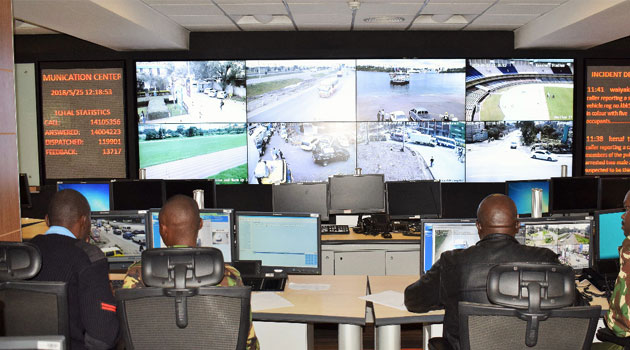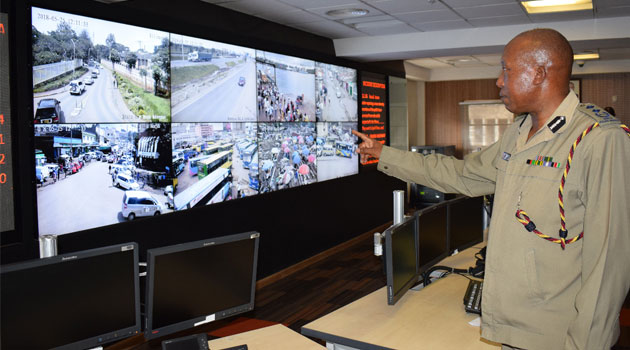
IC3, according to police, has helped in reducing cases of crime in the two major cities in the country/MOSES MUOKI
NAIROBI, Kenya, May 25 – Three years after the Integrated, Control and Communication Centre was made operational, Capital FM News on Friday gained exclusive access to the key security installation at the National Police Headquarters, Nairobi.
Inside the centre, some 1,803 high definition CCTV cameras covering Nairobi and Mombasa Counties are monitored by specially trained police officers in a bid to thwart any security threat.
And even before we started our tour, the Capital FM News crew found police officers tracking down a hit and run vehicle.
“Roger, that vehicle is coming towards your location. It is currently near Mbagathi Hospital…it should be there in a few. Arrest him…” an officer at the control centre could be heard directing his counterpart on the ground.
From one side of the expansive centre, one can see a massive screen showing various parts of the two cities like Kasarani Stadium, Nyali Bridge, Mtongwe and Likoni ferries and other areas where the cameras have been installed.
From the screens, officers can see activities at say Jevanjee Gardens or Uhuru Park, and can even identify a person as witnessed by this reporter.
The big question is whether the Sh15 billion project has been of value to taxpayers?
We sought the answers from the National Police Service Director of IC3 Francis Gachina.
According to him, the IC3 operations have integrated the Command, Control, and Communication functions through the Emergency Call Centre, Dispatching Centre, and Critical Incident Management Suite.
“One of the main thing in this command centre is receiving emergency calls from the public through 999, 112 and 911 emergency numbers. All the emergency calls from the country are received within this command centre and then they are dispatched to the various officers in the field depending on the issue that has been brought up by the caller,” he explained.
If it is a call within Nairobi, he says “it is dispatched within this command centre because we have the resources of Nairobi area within.”
The officers on the ground can be seen through the surveillance cameras while their walkie-talkies can be tracked down through the Global Positioning System (GPS).
“From here, we can see the officers on the ground because every handset on the car and with officers has a GPS location, such that we can locate where an officer is when the need arises,” he said.
Through the Automatic Number Plate, Recognition Control System usually mounted on major roads and highways, detectives are able to pursue a blacklisted vehicle.
“Immediately a vehicle has been stolen and reported to this command centre, it is blacklisted, and when it goes through an Automatic Number Plate Recognition Control System camera, it is flagged, making it easier for the officers to inform the resources on ground on where the vehicle is located, so that it can be recovered,” he said.
Since its inception, the centre has received more than 14 million calls from Kenyans seeking police services.
There is also a traffic desk in the centre that helps officers on the ground manage the flow of vehicles.
“An officer who is at Global Interchange can’t be able to see what is happening some a hundred metres from where he is, like along Thika or Kipande Road, but the areas have been installed with CCTV cameras. From the traffic desk, he is advised on how to allow the flow of traffic,” the IC3 director explained.

IC3, according to police, has helped in reducing cases of crime in the two major cities in the country./MOSES MUOKI
This has helped improve the response time once an incident happens to between 10 and 15 minutes according to the director.
“We cannot be able to monitor all the 1,803 cameras that are on the ground. We pick cameras depending on the intelligence we have received and what is happening on a particular day. But this does not mean we cannot retrieve footage of a certain area in case of an incident,” he said.
“In most cases, we also send video clips to their handsets because they (Walkie-Talkie) are 4G enabled,” he said.
Since May 2015 when the centre became operational to last year December, police have blacklisted over 1,800 stolen vehicles.
Out of those, he said they have able to recover 720 vehicles using the Automatic Number Plate Recognition cameras.
“Since we installed the cameras, the areas which were prone to crime are way better,” he said.
What happens during or after the murder of people? Do the cameras still work?
It is a question many Kenyans wonder more so like during the murder of IEBC ICT manager Chris Msando in 2017.
Though his movements were well tracked, at some point, the cameras were not ‘working’ according to police.
But not all cameras, according to Gachina are under the IC3.
“Cameras were working. There are two sets of cameras in this city. Those that are under the IC3 programme and the cameras that were installed by the Metropolitan ministry…They are all within the CBD,” he said.
“They are not part of this command centre. All the cameras under IC3 work unless there is an issue of a power cut and they still store the images and videos for a maximum of 8 hours because we have a power backup in every camera.”

IC3, according to police, has helped in reducing cases of crime in the two major cities in the country/MOSES MUOKI
IC3, according to police, has helped in reducing cases of crime in the two major cities in the country.
During the night, the cameras depend on the lighting on the streets.
But in darkness, Gachina says the results to black and white.
The National Police Service plans to extend the programme to other towns in the country.
Kenya, just like any other country in the world has its good share of insecurity that ranges from “normal crime” and worse enough, terror attacks that have claimed hundreds of lives the worst being the April 2, 2015, Garissa University College attack that left 148 people dead.
Crime may not be fully eliminated but can be curbed or cases reduced if the right tools and measures are put in place.









































